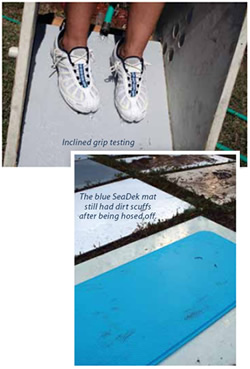
250
A good DIY nonskid offers effective traction (obviously) and is easy to apply, easy to clean, durable, and gentle enough on knees and elbows that a foredeck monkey won’t leave blood stains behind. Testers focused on these criteria during bench testing, and when considering final ratings, we weighed the results according to their importance. For example, a product that had great grip but was hard to clean rated better overall than one that was easy to clean but offered no traction. This was a fairly close race, so we used a plus-minus system in the ratings (see accompanying Value Guide)—something we don’t often do—as every point mattered.
To determine ease of application, testers prepped 11 24- by 16-inch fiberglass panels and applied the products per maker’s instructions. Testers also noted how clear and easy to understand the instructions were.
For the pre-mixed paints, testers stirred each one well using a mixing-paddle on a power drill—so that the aggregate was evenly distributed—before laying it on in two coats.
To apply the additive-only products, testers used the mix-in method to affect a more apples-to-apples comparison with the pre-mixed paints and to ensure we had consistent grit. To determine whether application method has any significant impact on traction, we plan to re-apply the three additives to new test panels using a combination mix-in and shaker distribution for a follow-up report.
For this test, we mixed the additives (in equal amounts) with Interlux Perfection and Epifanes Polyurethane, which are both two-part polyurethanes that were recommended in our most recent long-term test of topside paints (PS, February 2011), but the additives can be used with most any marine deck paint.
Note that some nonskid additives are actual grit while others are micro spheres, or beads, which act as tiny shape formers for the paint. The beads actually break down with time, creating new micro edges for traction; however, they also tend to trap dirt more vigorously than granules.
The only paint that did not contain a nonskid compound was the KiwiGrip. Testers applied it in two coats, laying it on with a brush and then texturing it with the company’s supplied “loopy-goopy” roller.
Nonskid mats, unless they are custom ordered, must be cut to fit before they are glued down. The SeaDek test sample came pre-cut and is self-adhesive, so testers needed only peel off the paper backing and lay it down. For the Treadmaster, testers cut a section to fit our test panel, spread the company’s self-branded epoxy on the mat back, and then laid it on the test panel.
To test grip, we mounted the test panels on a jig that allowed the panels to be inclined at measured heeling angles. With a tester standing on the panel, the incline was increased in 5-degree increments until the tester slipped. We repeated the test while wearing boat shoes and with bare feet, and with the panels wet and dry. The accompanying “Nonskid Traction Test Results” table lists the maximum angle testers were able to stand on the panel.
To further evaluate resistance, testers dragged a 10-pound weight attached to a slick shoe tread across the finished surfaces, measuring the resistance with a load scale. The Value Guide lists the pounds of pull required to move the weighted tread 1.5 feet.
Once grip tallies were in, we set out to see how easy the finishes were to clean. Testers tromped through wet soil in boat shoes, then walked, stomped, danced, and skidded across the panels, caking them with mud—a case of extreme dirty that few boat decks will see. If a panel came clean with a simple hosing off, we rated it Excellent. Panels with scuffs and trapped dirt that easily came off with a soft-bristle brush were rated Good, and those with dirt remaining on raised areas or crannies were rated Fair. All of the panels withstood scrubbing with a stiff brush; no grit came off or paint peeled.
To get an idea of how rough the surfaces would be on knees, elbows, feet, and bums, testers spent time kneeling and sitting on each one. Testers also made observations on the uniformity of grit. Price and availability also were considered in final ratings.








































